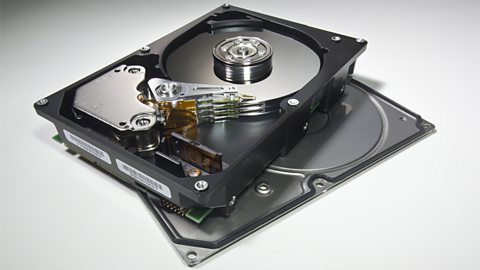The need for secondary storage
Computers use main memoryThe part of a computer that stores data. such as random access memory RAMRandom access memory. This is volatile memory that is constantly being written to and read from. It does not retain its contents without a constant supply of power. When a computer is turned off, everything stored in its RAM is lost. and cache memoryA piece of temporary memory. It can refer to a part of the RAM, storage disk, CPU, or an area for storing web pages. to hold dataUnits of information. In computing there can be different data types, including integers, characters and Boolean. Data is often acted on by instructions. that is being processed. However, this type of memory is volatile - it loses its contents when the computer is switched off. general purpose computerA computer designed to be able to carry out a wide range of instructions., such as personal computers and tablets, need to be able to store programSequences of instructions for a computer. and data for later use.
secondary storageNon-volatile memory external to the CPU and used for long-term storage of programs and data. is non-volatile, long-term storage. Without secondary storage all programs and data would be lost the moment the computer is switched off.
There are three main types of secondary storage in a computer system:
- solid state storage devices, such as USB memory sticks
- optical storage devices, such as CD, DVD and Blu-ray discs
- magnetic storage devices, such as hard disk drives
However, not all computers require secondary storage. embedded systemA special purpose computer built into another device., such as those found in a washing machine or central heating system, do not need to store data when the power is turned off. The instructionA single action that can be performed by a computer processor. needed to run them are stored in read-only memory (ROM) and any user data is held in RAM.
Solid state
Solid state storage is a special type of storage made from silicon microchips. It can be written to and overwritten like RAM. However, unlike RAM, it is non-volatile, which means that when the computer's power is switched off, solid state storage will retain its contents.
Solid state is also used as external secondary storage, for example in USB memory sticks and solid state drives.
One of the major benefits of solid state storage is that is has no moving parts. Because of this, it is more portable, and produces less heat compared to traditional magnetic storage devices. Less heat means that components last longer.
Solid state storage is also faster than traditional hard disk driveA device used to store large amounts of data. because the data is stored electrically in silicon chips called cells. Within the cells, the binaryA number system that contains two symbols, 0 and 1. Also known as base 2. data is stored by holding an electrical current in a transistor with an on / off mode. Unlike RAM which uses a similar technique, solid state storage retains this even when the power is switched off by using a technology known as flash memory.
Solid state is an ideal storage medium for many modern devices such as tablets, smartphones and digital cameras.
Magnetic devices
Magnetic devices such as hard disk drives use magnetic fields to magnetise tiny individual sections of a metal spinning disk. Each tiny section represents one bit. A magnetised section represents a binary '1' and a demagnetised section represents a binary '0'. These sections are so tiny that disks can contain terabytes (TB) of data.
As the disk is spinning, a read/write head moves across its surface. To write data, the head magnetises or demagnetises a section of the disk that is spinning under it. To read data, the head makes a note of whether the section is magnetised or not.
Magnetic devices are fairly cheap, high in capacity and durable. However, they are susceptible to damage if dropped. They are also vulnerable to magnetic fields - a strong magnet might possibly erase the data the device holds.
Optical devices
Optical devices use a laser to scan the surface of a spinning disc made from metal and plastic. The disc surface is divided into tracks, with each track containing many flat areas and hollows. The flat areas are known as lands and the hollows as pits.
When the laser shines on the disc surface, lands reflect the light back, whereas pits scatter the laser beam. A sensor looks for the reflected light. Reflected light - land - represents a binary '1', and no reflection - pits - represents a binary '0'.
There are different types of optical media:
- ROM media have data pre-written on them. The data cannot be overwritten. Music, films, software and games are often distributed this way.
- Read (R) media are blank. An optical device writes data to them by shining a laser onto the disc. The laser burns pits to represent '0's. The media can only be written to once, but read many times. Copies of data are often made using these media.
- Read/write RW works in a similar way to R, except that the disc can be written to more than once.

Image caption, Hard disk
Image caption, CD-ROM
Image caption, DVD
Image caption, USB memory stick
1 of 4